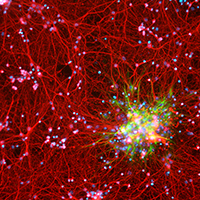Quantitative, structural and molecular changes in neuroglia of aging mammals: A review

Accepted: 27 May 2021
HTML: 11
All claims expressed in this article are solely those of the authors and do not necessarily represent those of their affiliated organizations, or those of the publisher, the editors and the reviewers. Any product that may be evaluated in this article or claim that may be made by its manufacturer is not guaranteed or endorsed by the publisher.
Authors
The neuroglia of the central and peripheral nervous systems undergo numerous changes during normal aging. Astrocytes become hypertrophic and accumulate intermediate filaments. Oligodendrocytes and Schwann cells undergo alterations that are often accompanied by degenerative changes to the myelin sheath. In microglia, proliferation in response to injury, motility of cell processes, ability to migrate to sites of neural injury, and phagocytic and autophagic capabilities are reduced. In sensory ganglia, the number and extent of gaps between perineuronal satellite cells – that leave the surfaces of sensory ganglion neurons directly exposed to basal lamina– increase significantly. The molecular profiles of neuroglia also change in old age, which, in view of the interactions between neurons and neuroglia, have negative consequences for important physiological processes in the nervous system. Since neuroglia actively participate in numerous nervous system processes, it is likely that not only neurons but also neuroglia will prove to be useful targets for interventions to prevent, reverse or slow the behavioral changes and cognitive decline that often accompany senescence.
How to Cite
PAGEPress has chosen to apply the Creative Commons Attribution NonCommercial 4.0 International License (CC BY-NC 4.0) to all manuscripts to be published.
Similar Articles
- C. Fede, I. Fortunati, L. Petrelli, D. Guidolin, R. De Caro, C. Ferrante, G. Albertin, An easy-to-handle microfluidic device suitable for immunohistochemical procedures in mammalian cells grown under flow conditions , European Journal of Histochemistry: Vol. 58 No. 2 (2014)
- M. Hinken, S. Halwachs, C. Kneuer, W. Honscha, Subcellular localization and distribution of the reduced folate carrier in normal rat tissues , European Journal of Histochemistry: Vol. 55 No. 1 (2011)
- H. Valpotić, A. Kovšca Janjatović, G. Lacković, F. Božić, V. Dobranić, D. Svoboda, I. Valpotić, M. Popović, Increased number of intestinal villous M cells in levamisole - pretreated weaned pigs experimentally infected with F4ac+ enterotoxigenic Escherichia coli strain , European Journal of Histochemistry: Vol. 54 No. 2 (2010)
- X.C. Xu, X. Abuduhadeer, W.B. Zhang, T. Li, H. Gao, Y.H. Wang, Knockdown of RAGE inhibits growth and invasion of gastric cancer cells , European Journal of Histochemistry: Vol. 57 No. 4 (2013)
- Yiyu Qin, Jian Li, Hongchao Han, Yongliang Zheng, Haiming Lei, Yang Zhou, Hongyan Wu, Guozhe Zhang, Xiang Chen, Zhengping Chen, SNORA38B promotes proliferation, migration, invasion and epithelial-mesenchymal transition of gallbladder cancer cells via activating TGF-β/Smad2/3 signaling , European Journal of Histochemistry: Vol. 67 No. 4 (2023)
- Jiangmu Chen, Zongchi Chen, Weitao Hu, Daxing Cai, Tumor cell-derived exosomal lncRNA LOC441178 inhibits the tumorigenesis of esophageal carcinoma through suppressing macrophage M2 polarization , European Journal of Histochemistry: Vol. 66 No. 4 (2022)
- Jana Oswald, Maximilian Büttner, Simon Jasinski-Bergner, Roland Jacobs, Philip Rosenstock, Heike Kielstein, Leptin affects filopodia and cofilin in NK-92 cells in a dose- and time-dependent manner , European Journal of Histochemistry: Vol. 62 No. 1 (2018)
- A.R.M. Sabbatini, L. Mattii, B. Battolla, E. Polizzi, D. Martini, M. Ranieri-Raggi, A.J.G. Moir, A. Raggi, Evidence that muscle cells do not express the histidine-rich glycoprotein associated with AMP deaminase but can internalise the plasma protein , European Journal of Histochemistry: Vol. 55 No. 1 (2011)
- Minkai Cao, Deping Yuan, Hongxiu Jiang, Guanlun Zhou, Chao Chen, Guorong Han, Long non-coding RNA WAC antisense RNA 1 mediates hepatitis B virus replication in vitro by reinforcing miR-192-5p/ATG7-induced autophagy , European Journal of Histochemistry: Vol. 66 No. 3 (2022)
- J. Melrose, The knee joint loose body as a source of viable autologous human chondrocytes , European Journal of Histochemistry: Vol. 60 No. 2 (2016)
<< < 3 4 5 6 7 8 9 10 11 12 > >>
You may also start an advanced similarity search for this article.

 https://doi.org/10.4081/ejh.2021.3249
https://doi.org/10.4081/ejh.2021.3249










